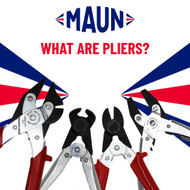What Are Pliers?
9th May 2023
Pliers are versatile tools that are essential for any toolbox. You can use them for gripping, bending, cutting, crimping, and more.
In this post, we’re going in deep to understand what pliers are, their important features and characteristics, and how to use them.
What are pliers and how do they work?

Pliers are hand tools designed to grip and manipulate objects or cut through tough materials. They consist of two metal jaws attached to handles and joined together by a pivot point.
Pliers are so useful because of the “law of the lever”, whereby the greater distance you have between a lever (the handles) and the pivot point, the greater force is applied to the other fixed side of the pivot (the gripping/cutting jaws).
This takes the force applied at the handle end, and greatly
multiplies it into the force applied at the jaw end, allowing a human hand to
grip very tightly, or cut through very hard objects without much effort.
The image above shows how the law of the lever applies to a standard pair of pliers. In the example shown, the force in the middle of the jaws is equal to 5 times the force applied to the handle.
What are pliers used for?

Broadly, pliers are used for gripping, cutting, and bending objects. There are also pliers designed for specific tasks, such as tongue-and-groove pliers (for gripping and turning non-uniform nuts) and insulated pliers (to protect from the dangers of live electrical wires).
We have much more specific information on the uses of pliers in the following sections:
How to choose pliers
Here we go over the common differentiating factors between different pliers, and why you may choose each type.
Jaw action
This is the way the plier jaws move, and there are two main types:
Scissor-action

With scissor-action pliers, the jaws open and close around a single pivoting joint, in the same way as traditional scissors.
This means the closer you move your workpiece towards the pivoting joint within the jaws, the more pressure is applied.
They tend to be the cheapest option but aren’t good at gripping smaller or delicate objects. They’re also harder to use, so your hand will get tired more quickly than when using parallel-action pliers.
Parallel-action

Parallel pliers (also called parallel-action pliers) use a box joint system that lets the jaws close in parallel to each other.
They are more expensive than scissor-action pliers, but they provide a much better grip because they create a larger contact area with your workpiece, which increases friction.
This helps to reduce the energy required for gripping, allowing you to grip for longer periods. It also allows you to be more accurate with the way you manipulate objects, particularly important during complex jewellery designs or manipulating wire.
Learn more about parallel pliers here .
Jaw Surface
Serrated Jaws

Serrated jaws on pliers provide extra grip on your workpiece. They do however risk scratching delicate pieces, and so shouldn’t be used on soft metals that are intended for show.
Smooth Jaws

Smooth jaw pliers are used when you want to preserve the surface of the workpiece, such as in jewellery or model making, and craft work. These jaws prevent any indentations or scratches.
V-slot

This isn’t a common feature, but it’s useful when you’re gripping metal wire. The jaws have a groove that’s designed to hold the wire all the way around, increasing the surface area and therefore the grip.
Open-throat
Another rare feature is open-throated pliers, can have wire threaded down the entire length of the tool, which allows you to grip/bend at any point of a long wire piece. This opens up a range of possibilities that traditional pliers don’t allow you to do.
*Side note, both the V-slot and open-throat are features of Maun Side Cutter Parallel Pliers .
Nose Shape
The shape of the plier jaws is referred to as the “nose”.
Here are the common types and their uses:
Flat nose

Flat nose pliers are the standard type, with two thick, flat-shaped jaws, ideal when you need a good grip on easy-to-access objects.
Snipe nose

Snipe nose or chain-nose pliers have tapered, pointed jaws that help you be more precise with your gripping. They’re commonly used in jewellery making, modelling, or fine electrical work. They allow you to reach into smaller spaces than traditional pliers too.
Round nose
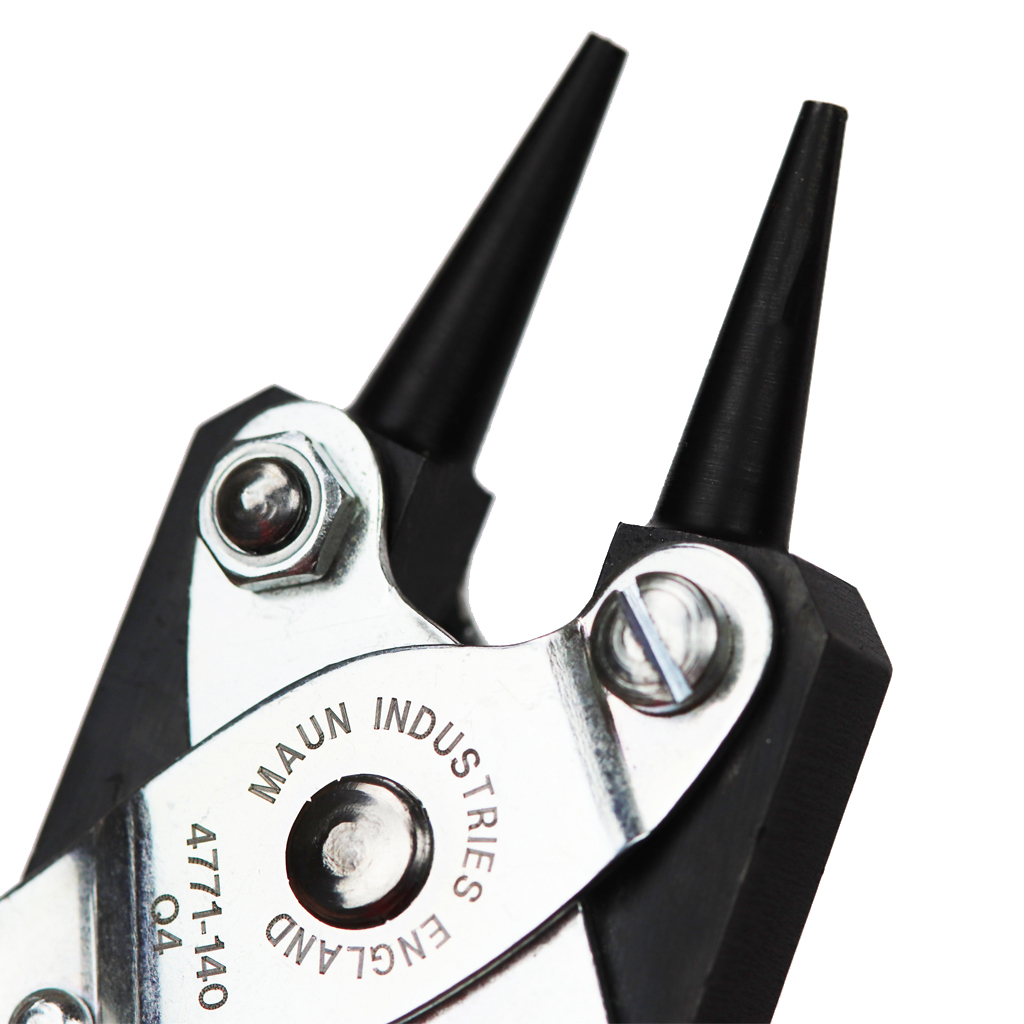
Round nose pliers have at least one jaw that’s rounded, used for creating bends in wire and metal. This is useful for jewellery making, more specifically for making rings.
Bent nose
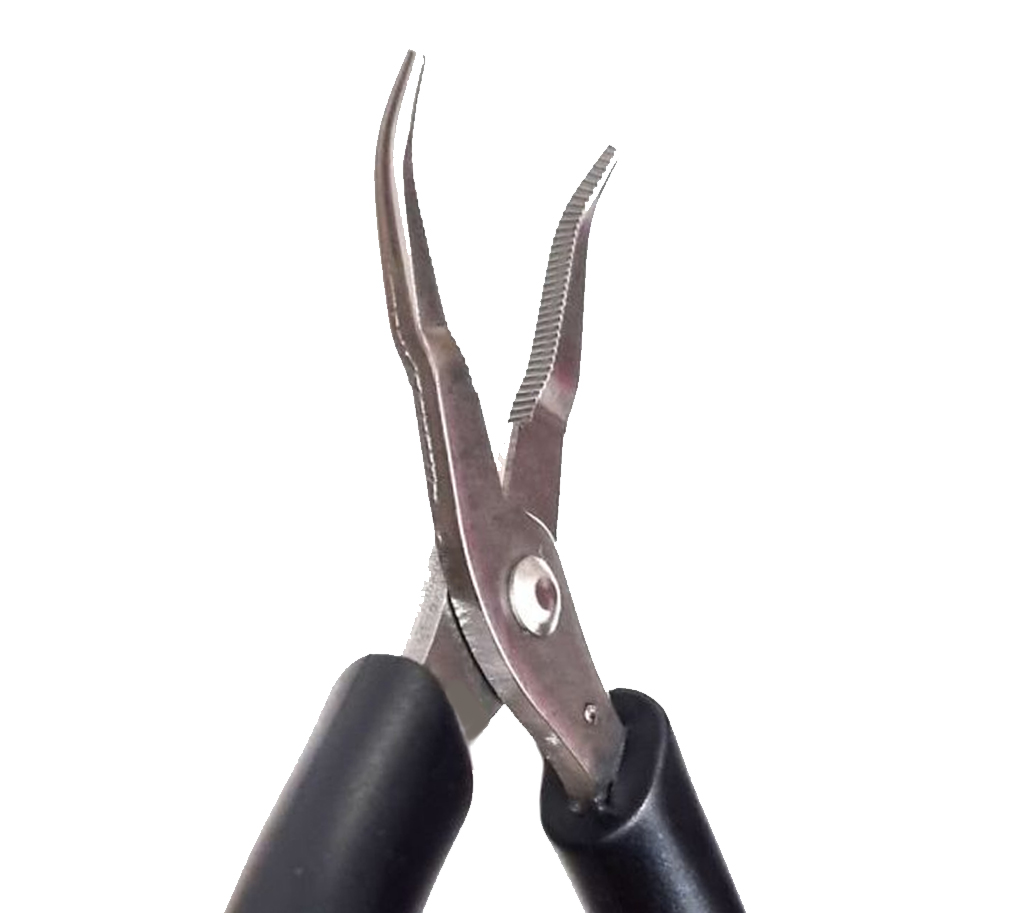
Bent nose pliers have angled jaws that help them to grip at awkward angles, that straight jaw pliers wouldn’t be able to access. This can be useful for reaching obstacles in the middle of an existing workpiece.
Needle nose/Long nose

Needle nose and long nose pliers have long, pointed jaws, ideal for gripping in very hard-to-reach areas.
Cutting Edge

Hardness
The hardness of the pliers’ cutting edge will determine how long it takes for it to go blunt from use. This is measured using the Rockwell hardness scale (HRC) that records the depth of penetration of an indenter into the surface of a material.
Maun recommends you use induction-hardened jaws for cutting pliers with a HRC value of 57-64.
Cutting edge thickness
The thickness of the cutting edge determines what it’s useful for. A thicker blade should be used for cutting heavy-duty wire, as this provides more leverage against a single piece of wire. Whereas cutting through multiple thinner strands of wire is better with a narrow cutting edge.
Blade angle
The angle of the cutting edge should differ depending on the material you’re cutting and what you want the final cut to look like.
- Diagonal cutters have a blade at a 45-degree angle to the handles and are ideal for cutting metal wire or electrical cables.
- Pliers with straight blades are used to cut through thinner and softer wire, as well as plastic cable ties.
- End-cutting pliers have flat blades at the end, designed to trim objects close to a surface.
- Shearing-action pliers act like scissors and are designed to cut through sheet metal, leather, and rubber.
Blade material
The majority of plier cutting edges will be made from steel. Maun recommends choosing pliers made from medium- or high-carbon steel, as this improves durability and helps maintain a sharp cutting edge.
Pliers Size

The larger the pliers you choose, the more leverage they will have, and so the greater gripping or cutting force you will achieve with them.
However, if you want to be more precise, then a smaller tool will give you more control.
So, you need to choose the right size of pliers for the job you wish to do with them.
For example, 125 mm Snipe Nose Pliers are great for gripping smaller objects in a tight space, whereas for cutting and gripping tough hard wire, you’ll want a set of 200 mm Side Cutter Parallel Pliers .
Pliers for specific tasks
Diagonal cutting pliers

Diagonal cutting pliers (also known as “side cutters” or “snips”) are used for cutting through wire and other materials. They have angled jaws that create a flush cut, doing so by first indenting the object and then wedging it apart.
Learn more about them here: What are diagonal cutting pliers?
End cutters

End cutters (or “end cutting pliers”) are used for cutting wire or nails very close to flat objects. This is possible because the jaws are perpendicular to the handles, and they’re very flat.
Learn more about them here: What are end-cutting pliers?
Plastic jaw pliers

Plastic jaw pliers are designed to be non-marking, so you can grip delicate or fragile materials without damaging them. They are very commonly used in fine jewellery making.
Crimping pliers
Crimpling pliers are used to install an electrical crimp, which is a solderless electrical connection, often for terminating stranded wires or installing them into an electrical terminal.
Learn more about them here: What is a crimping tool?
Jewellery pliers
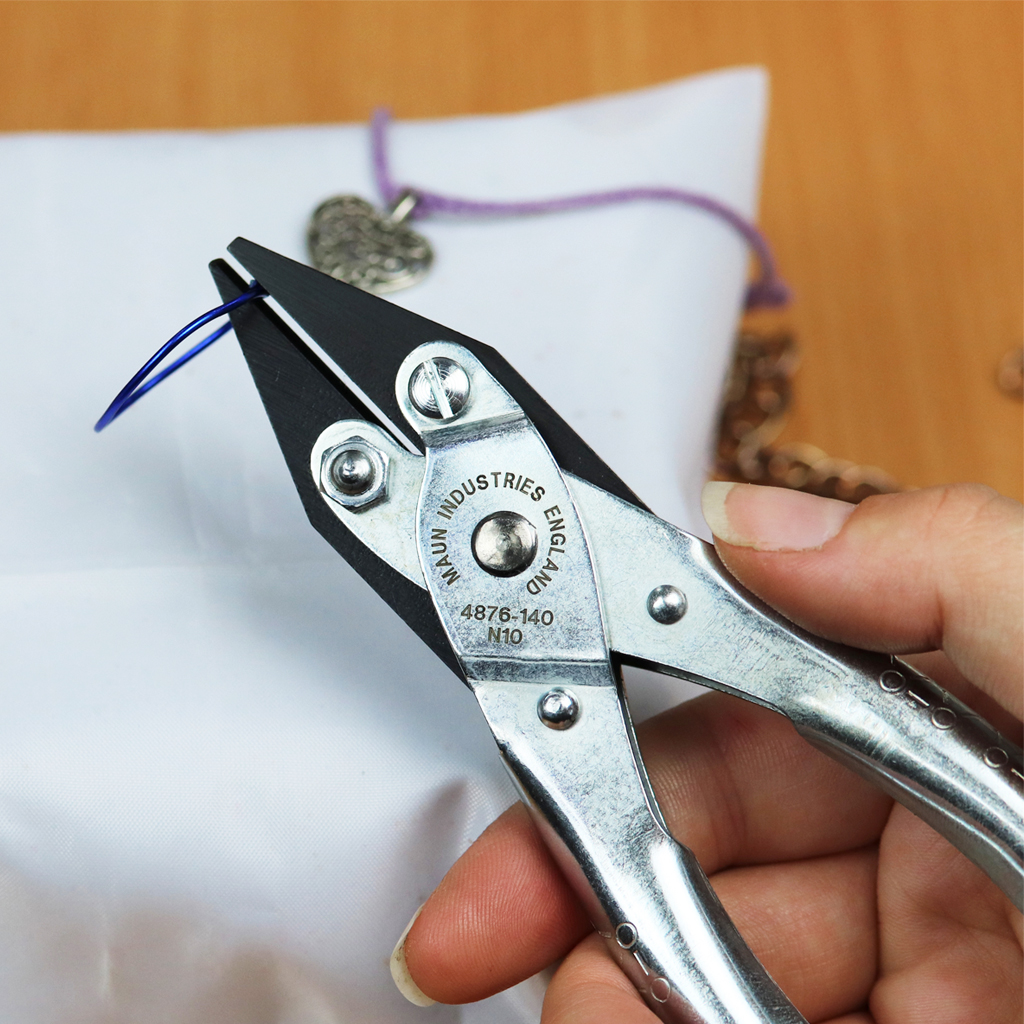
Jewellery pliers are an overarching category that contains many specific types of pliers used for jewellery making. This includes forming wire shapes, making loops, cutting wire, crimping beads, creating jump rings, and gripping smaller items.
Learn more about them here: What are jewellery pliers? | Best jewellery pliers
Fencing pliers

Fencing pliers are a type of pliers designed to install and maintain agricultural fencing. They’re particularly useful for high-tensile electrical fence wire and will be able to both grip and cut through hard wire.
Learn more about them here: What are fencing pliers? | Best fencing pliers
Combination pliers
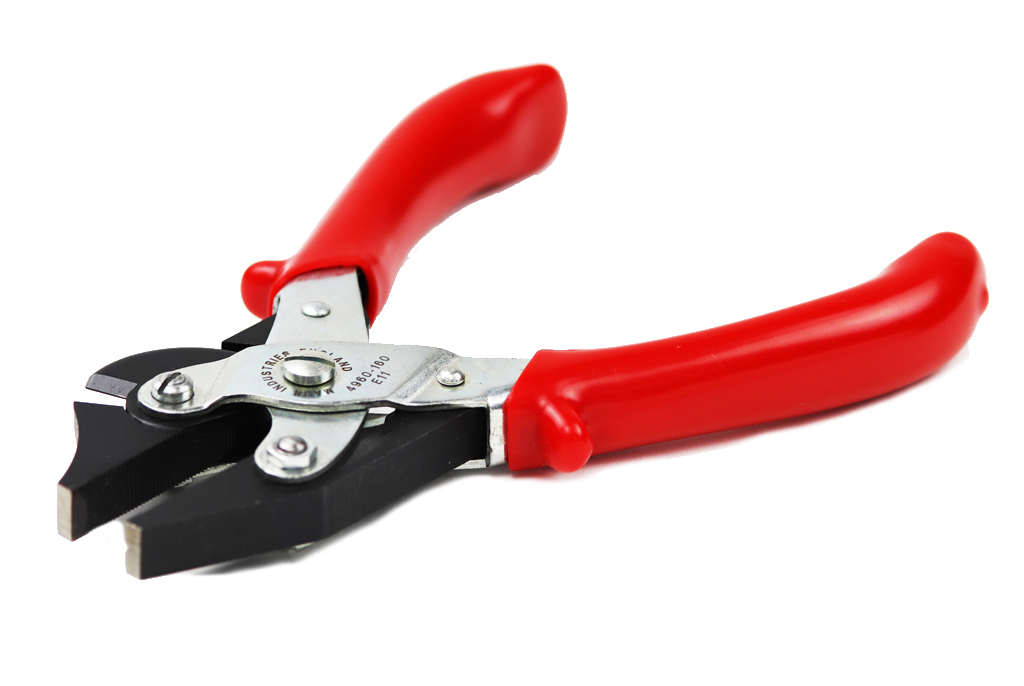
Combination pliers usually refer to a set of pliers that can both grip and cut objects. They do this by having two types of jaws that can be operated using the same handles, allowing you to quickly switch between tasks.
Locking pliers

Locking pliers are traditional gripping pliers that can be locked in place, allowing you to let go of the pliers without them becoming loose. This can be useful when working with multiple objects at once, such as working on an intricate model.
Tongue-and-groove pliers
Tongue-and-groove pliers (also known as “slip-joint pliers” or “water pump pliers”) have an adjustable pivot point that lets them be adjusted to fit multiple sizes of nuts. Usually used by plumbers for adjusting pipework.
Circlip pliers
Circlip pliers (also known as “retaining ring pliers”) are designed for installing and removing circlips, which are a type of fastener that works like a retaining ring (a fastener holding components onto a shaft or in a bore).
Insulated pliers
Insulated pliers are usually side cutters that have insulated handles, to stop electrical current conducting through them and harming a person. They are very commonly used by electricians.
You can learn more about types of pliers here .
| Type of Pliers | Primary Use | Advantages | Disadvantages |
|---|---|---|---|
| Parallel Pliers | Provide a firmer grip on surfaces; used on square or hexagonal fastenings and wire. | Spreads pressure over a larger surface area. | May not be suitable for very fine or detailed work. |
| Cutting Pliers | Cut through a wide range of materials. | Minimal hand effort required. | Not designed for gripping or bending tasks. |
| Combination Pliers | Fulfil multiple functions; e.g., gripping, bending, and cutting wire. | Speeds up workflow; reduces need to swap tools. |
The smaller cutting jaws aren't suitable for very wide materials.
|
| End Cutting Pliers | Cut off loose ends of wire; remove nails or old bolts. | Precise flush cutting; can also be used for removal tasks (like old nails). | Limited to end cutting; not as useful for general cutting tasks. |
| Round Nose Pliers | Bend wire; primarily used in jewelry making. | Can form even loops of multiple sizes. | Not suitable for tasks requiring flat grip. |
| Needle Nose Pliers | Grip and bend light materials in confined spaces. | Long jaws for precision work. | Not ideal for heavy-duty tasks due to slender design. |
| Clamping Parallel Pliers | Locking mechanism to hold items without manual grip. | Allows multitasking; firm grip. |
Locking mechanism may get in the way if used in tight spaces.
|
| Crimping Pliers | Install solderless electrical connections. | Creates a secure seal/connection. | Specific to crimping tasks; not versatile. |
| Olive Cutting Pliers | Cut olives from pipework. | Safer and more precise than other methods. | Limited to cutting olives; not for general use. |
| Jewellery Pliers | Designed for intricate tasks in jewelry making. | Specifically tailored for delicate work. | Not suitable for heavy-duty or general tasks. |
Using pliers safely
To use pliers, you hold the tool in one hand, place the workpiece you want to bend or cut in the jaws, then apply gripping force to the handles.
There are some simple things you can do to ensure you’re using your pliers safely:
1. Eye protection – make sure to wear goggles when cutting materials that could harm you.
2. Gloves – make sure your hands are protected properly when dealing with sharp materials.
3. Long sleeves – this will ensure your skin is protected from flying bits of sharp metal.
4. Ensure no live wires – never use pliers on live wires.
Learn more here: How to use pliers
Maintaining Pliers
To properly care for your pliers, follow these tips:
1. Clean – clean your pliers after each use with a clean rag, to remove debris or residue.
2. Oil – apply a light coat of oil to the pliers’ jaws to prevent rust.
3. Sharpening – sharpen your tool with a file or sharpening stone to remove any nicks or burrs.
4. Proper storage – store them in a cool dry place.
Conclusion
We hope you enjoyed our post on pliers.
Browse our related posts below, or contact us with any questions:

